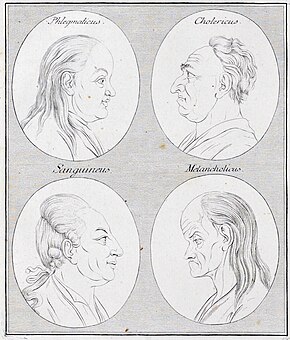| Personality test | |
|---|---|
 The four temperaments as illustrated by Johann Kaspar Lavater | |
| MeSH | D010556 |
A personality test is a method of assessing human personality constructs. Most personality assessment instruments (despite being loosely referred to as "personality tests") are in fact introspective (i.e., subjective) self-report questionnaire (Q-data, in terms of LOTS data) measures or reports from life records (L-data) such as rating scales.[1][2] Attempts to construct actual performance tests of personality have been very limited even though Raymond Cattell with his colleague Frank Warburton compiled a list of over 2000 separate objective tests that could be used in constructing objective personality tests.[3] One exception, however, was the Objective-Analytic Test Battery, a performance test designed to quantitatively measure 10 factor-analytically discerned personality trait dimensions.[4][5] A major problem with both L-data and Q-data methods is that because of item transparency, rating scales, and self-report questionnaires are highly susceptible to motivational and response distortion ranging from lack of adequate self-insight (or biased perceptions of others) to downright dissimulation (faking good/faking bad) depending on the reason/motivation for the assessment being undertaken.[6][7][8]
The first personality assessment measures were developed in the 1920s[9] and were intended to ease the process of personnel selection, particularly in the armed forces. Since these early efforts, a wide variety of personality scales and questionnaires have been developed, including the Minnesota Multiphasic Personality Inventory (MMPI), the Sixteen Personality Factor Questionnaire (16PF), the Comrey Personality Scales (CPS), among many others.[10][11] Although popular especially among personnel consultants, the Myers–Briggs Type Indicator (MBTI) has numerous psychometric deficiencies.[12] More recently, a number of instruments based on the Five Factor Model of personality have been constructed such as the Revised NEO Personality Inventory.[13] However, the Big Five and related Five Factor Model have been challenged for accounting for less than two-thirds of the known trait variance in the normal personality sphere alone.[14][15][16]
Estimates of how much the personality assessment industry in the US is worth range anywhere from $2 and $4 billion a year (as of 2013).[17] Personality assessment is used in wide a range of contexts, including individual and relationship counseling, clinical psychology, forensic psychology, school psychology, career counseling, employment testing, occupational health and safety and customer relationship management.
- ^ Cattell R.B. (1973). Personality and Mood by Questionnaire. San Francisco, CA: Jossey-Bass. ISBN 0-87589-181-0.
- ^ Cattell, R.B., & Kline, P. (1977). The Scientific Analysis of Personality and Motivation. New York: Academic Press.
- ^ Cattell, R.B., & Warburton, F.W. (1967). Objective Personality and Motivation Tests: A Theoretical Introduction and Practical Compendium. Champaign, IL: University of Illinois Press.
- ^ Cattell, R.B., & Schuerger, J.M. (1978). Personality Theory in Action: Handbook for the O-A (Objective-Analytic) Test Kit. Champaign, Illinois: Institute for Personality and Ability Testing. ISBN 0-918296-11-0.
- ^ Schuerger, J.M. (2008). The Objective-Analytic Test Battery. In G.J. Boyle, G. Matthews, & D.H. Saklofske. (Eds.), The SAGE Handbook of Personality Theory and Assessment: Vol. 2 – Personality Measurement and Testing (pp. 529-546). Los Angeles, CA: Sage Publishers. ISBN 9-781412-946520.
- ^ Boyle, G.J. (1985). Self-report measures of depression: Some psychometric considerations. British Journal of Clinical Psychology, 24, 45-59.
- ^ Boyle, G.J., & Helmes, E. (2009). Methods of personality assessment. In P.J. Corr & G. Matthews (Eds.), The Cambridge Handbook of Personality Psychology (pp. 110-126). Cambridge, UK: Cambridge University Press. ISBN 978-0-521-86218-9.
- ^ Boyle, G.J., Saklofske, D.H., & Matthews, G. (2015). (Eds.), Measures of Personality and Social Psychological Constructs. Amsterdam: Elsevier/Academic Press. doi:10.1016/B978-0-12-386915-9.00001-2. ISBN 9-780123-869159.
- ^ Saccuzzo, Dennis P.; Kaplan, Robert M. (2009). Psychological Testing: Principles, Applications, and Issues (7th ed.). Belmont, CA: Wadsworth Cengage Learning. ISBN 978-0495095552.
- ^ Boyle, G.J., Matthews, G., & Saklofske, D.H. (2008). (Eds.), The SAGE Handbook of Personality Theory and Assessment: Vol. 1 - Personality Theories and Models. Los Angeles, CA: Sage Publishers. ISBN 9-781412-946513
- ^ Boyle, G.J., Matthews, G., & Saklofske, D.H. (2008). (Eds.), The SAGE Handbook of Personality Theory and Assessment: Vol. 2 - Personality Measurement and Testing. Los Angeles, CA: Sage Publishers. ISBN 9-781412-946520
- ^ Boyle, G.J. (1995). Myers-Briggs Type Indicator (MBTI): Some psychometric limitations. Australian Psychologist, 30, 71-74.
- ^ Costa, P.T., & McCrae, R.R. (1985). The NEO Personality Inventory Manual. Odessa, FL: Psychological Assessment Resources.
- ^ Boyle, G.J. (2008). Critique of Five-Factor Model (FFM). In G.J. Boyle, G. Matthews, & D.H. Saklofske. (Eds.), The SAGE Handbook of Personality Theory and Assessment: Vol. 1 - Personality Theories and Models. Los Angeles, CA: Sage Publishers. ISBN 9-781412-946513
- ^ Cattell, R.B. (1995). The fallacy of five factors in the personality sphere. The Psychologist, 8, 207-208.
- ^ Eysenck, H.J. (1992). Four ways five factors are not basic. Personality and Individual Differences, 13, 667-673.
- ^ "Personality Testing at Work: Emotional Breakdown". The Economist.